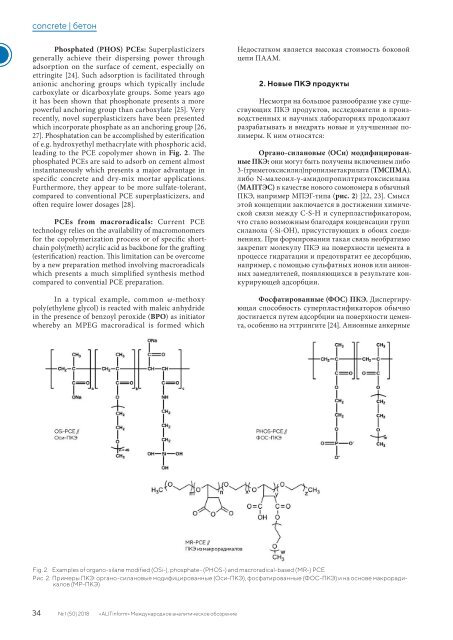AlitInform 50
“ALITinform” is a periodical that covers different aspects in production and applications of cement, concrete, and dry building mixtures. Pages of this journal offer contributions from leading Russian and International scientists, technologists and leading professionals, news from the stock markets, research laboratories, latest elaborations by producers and suppliers of modern building materials and equipment. The magazine goal is to unite on its pages the articles of the leading Russian and International specialists in the field of cement, concrete, dry building mixtures; latest news of the Russian and world building materials market, the traditions of peer-reviewed Russian scientific magazines and innovative informational approach of the contemporary printed media. The prime focus is on developments serving the purpose of rationalization of production, reduction of energy consumption, enhancement of quality and improvement of environmental safety. _______________________________________
“ALITinform” is a periodical that covers different aspects in production and applications of cement, concrete, and dry building mixtures. Pages of this journal offer contributions from leading Russian and International scientists, technologists and leading professionals, news from the stock markets, research laboratories, latest elaborations by producers and suppliers of modern building materials and equipment.
The magazine goal is to unite on its pages the articles of the leading Russian and International specialists in the field of cement, concrete, dry building mixtures; latest news of the Russian and world building materials market, the traditions of peer-reviewed Russian scientific magazines and innovative informational approach of the contemporary printed media. The prime focus is on developments serving the purpose of rationalization of production, reduction of energy consumption, enhancement of quality and improvement of environmental safety.
_______________________________________
Create successful ePaper yourself
Turn your PDF publications into a flip-book with our unique Google optimized e-Paper software.
concrete | бетон<br />
Phosphated (PHOS) PCEs: Superplasticizers<br />
generally achieve their dispersing power through<br />
adsorption on the surface of cement, especially on<br />
ettringite [24]. Such adsorption is facilitated through<br />
anionic anchoring groups which typically include<br />
carboxylate or dicarboxylate groups. Some years ago<br />
it has been shown that phosphonate presents a more<br />
powerful anchoring group than carboxylate [25]. Very<br />
recently, novel superplasticizers have been presented<br />
which incorporate phosphate as an anchoring group [26,<br />
27]. Phosphatation can be accomplished by esterification<br />
of e.g. hydroxyethyl methacrylate with phosphoric acid,<br />
leading to the PCE copolymer shown in Fig. 2. The<br />
phosphated PCEs are said to adsorb on cement almost<br />
instantaneously which presents a major advantage in<br />
specific concrete and dry-mix mortar applications.<br />
Furthermore, they appear to be more sulfate-tolerant,<br />
compared to conventional PCE superplasticizers, and<br />
often require lower dosages [28].<br />
PCEs from macroradicals: Current PCE<br />
technology relies on the availability of macromonomers<br />
for the copolymerization process or of specific shortchain<br />
poly(meth) acrylic acid as backbone for the grafting<br />
(esterification) reaction. This limitation can be overcome<br />
by a new preparation method involving macroradicals<br />
which presents a much simplified synthesis method<br />
compared to convential PCE preparation.<br />
In a typical example, common ω-methoxy<br />
poly(ethylene glycol) is reacted with maleic anhydride<br />
in the presence of benzoyl peroxide (BPO) as initiator<br />
whereby an MPEG macroradical is formed which<br />
Недостатком является высокая стоимость боковой<br />
цепи ПААМ.<br />
2. Новые ПКЭ продукты<br />
Несмотря на большое разнообразие уже существующих<br />
ПКЭ продуктов, исследователи в производственных<br />
и научных лабораториях продолжают<br />
разрабатывать и внедрять новые и улучшенные полимеры.<br />
К ним относятся:<br />
Органо-силановые (ОСи) модифицированные<br />
ПКЭ: они могут быть получены включением либо<br />
3-(триметоксисилил)пропилметакрилата (ТМСПМА),<br />
либо N-малеоил-γ-амидопропилтриэтоксисилана<br />
(МАПТЭС) в качестве нового сомономера в обычный<br />
ПКЭ, например МПЭГ-типа (рис. 2) [22, 23]. Смысл<br />
этой концепции заключается в достижении химической<br />
связи между C-S-H и суперпластификатором,<br />
что стало возможным благодаря конденсации групп<br />
силанола (-Si-OH), присутствующих в обоих соединениях.<br />
При формировании такая связь необратимо<br />
закрепит молекулу ПКЭ на поверхности цемента в<br />
процессе гидратации и предотвратит ее десорбцию,<br />
например, с помощью сульфатных ионов или анионных<br />
замедлителей, появляющихся в результате конкурирующей<br />
адсорбции.<br />
Фосфатированные (ФОС) ПКЭ. Диспергирующая<br />
способность суперпластификаторов обычно<br />
достигается путем адсорбции на поверхности цемента,<br />
особенно на эттрингите [24]. Анионные анкерные<br />
Fig. 2. Examples of organo-silane modified (OSi-), phosphate- (PHOS-) and macroradical-based (MR-) PCE<br />
Рис. 2. Примеры ПКЭ: органо-силановые модифицированные (Оси-ПКЭ), фосфатированные (ФОС-ПКЭ) и на основе макрорадикалов<br />
(МР-ПКЭ)<br />
34 № 1 (<strong>50</strong>) 2018 «ALITinform» Международное аналитическое обозрение



